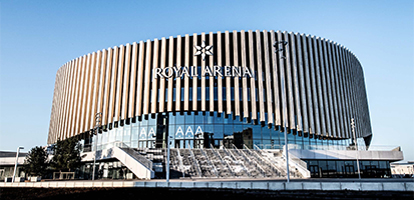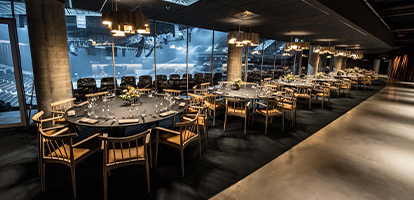


The Royal Arena is an imposing structure, with seating for 12,500 spectators. The lighting installation now comprises 187 DALI components from WAGO.
It is fitting in the multi-use history of the Royal Arena, that the legendary metal band, Metallica, with the Danish drummer, Lars Ulrich, opened the arena in Copenhagen with three concerts. With seating for 12,500, the structure is imposing in its dimensions, and is second to none among the arenas in other European metropolitan areas. Its lighting installations are also exemplary. Hoffmann Teknik installed a total of 44 control cabinets, including DALI equipment from WAGO: 187 DALI Master Modules and 531 DALI PIR Sensors. The exemplary feature is that DALI controls not only the lighting in the Royal Arena, but also the power supply.
According to the Hoffmann project manager, Jan Roed, this brought advantages, primarily during wiring, because the electricians only had to lay one cable, which saved time. That being said, the lighting experts still had to master several challenges. Changes in large projects during the construction phase are not uncommon, and they can have far-reaching consequences. One additional light fixture can tip the entire installation towards failure, and, in the worst case, can require more control cabinets and the laying of more cable.
Adjustments were also necessary in the Royal Arena. The DALI bus has a range of 300 meters, so the 44 control cabinets had to be strategically positioned. Since each DALI Master Module is supposed to control both lighting and power supply, the experts at Hoffmann were concerned about loads. To master the challenge, they installed 40 to 45 units in most modules.
However, changes and heavy loads made it necessary to equip a few modules with 60 units.
Challenging Project
Due to the complexity and the changes, it paid off that Hoffmann Teknik was already communicating with the other parties during the scheduling phase, because the experts were able to estimate the new demands quite well. “We had one technician in the project group, which really paid off in this situation,” according to Roed.
Around 30 additional firms, in addition to Hoffmann Teknik, were involved in the construction of the Royal Arena.
A tour of the building showcases their efforts: there is an impressive view of the hall, which seats up to 15,000 spectators for concerts, from the catwalk under the ceiling. One part of the seating area is flexibly installed. If the maximum number of seats are required, then additional rows can be quickly installed. Glass-fronted rooms are located around the gallery: VIP suites that can be rented by companies and individuals.
“We control the lighting from here as well, but in a specialized way,” says Roed. “In addition, the users have the ability to completely regulate the lighting using touchscreens. During events, the control center can override the local panels, and the lighting can be set to a specific light level.”
Aside from the concert hall and the hallways, the Royal Arena offers several spaces that normal guests do not visit. These are areas like the administrative wing, and the so-called back of house areas, where the artists playing the Royal Arena have access. In 2018, this will include bands like Metallica, and potentially Iron Maiden, Justin Timberlake, or U2.
Text: ALLAN MALMBERG
Photos: ROYAL ARENA